Competitive Intelligence (CI) deals with "what are they doing" rather than "how can we be better at what we are doing." Because of this difference in perspective, I think there are a number of insights we can gain by exploring their world.
Is this "Corporate Espionage"?
No, the Society of Competitive Intelligence Professionals (SCIP) is very clear that they are bound by a code of ethics and
that what they do is legal, above board, and CI is derived primarily from
passive intelligence gathering.They are not related to Mata Hari or James
Bond, but perhaps closer to "Q".As you would expect, some ex-intelligence
people, an abundance of PhDs, and other practitioners with market research
backgrounds populate this field.
They even have some interesting approaches to modeling, using events and possibilities as well as cause and effect.
A few weeks ago, at the SCIP conference, I saw a number of technologies that were the tools of Competitive Intelligence.These are systems that absorb massive amounts of data, create appropriate filters, show relationships and create tools for understanding what is happening within industries, markets, companies, import/export trends and even who owns what patents and what products or other patents have been derived from an original one.
There is abundant use of data portals and multiple portals to access both public and proprietary database information, in addition to copious library searches.Strangely missing seemed to be the creation of dossiers on people within an organization who were not corporate officers.It seemed that it would be highly desirable to know if the new marketing person had any great campaigns, special quirks, or had been the leader in some great marketing disasters.
But, more than the technology, there seemed to be some key approaches to their problems that have been well systemized.Of course, there was the time honored, SWOT (strengths, weaknesses, opportunities and threats)analysis as a basis for beginning to approach the questions of:
- What are "they" doing?
- How successful are "they" and why?
- Who are "their" key players?
- What is "their" financial strength?
- What technology, intellectual property or patents do "they" hold?
- How are "they" positioned in the industry?
- What trends can we identify?
- What relationships are key with the competition?
- What changes internally do "they" have that may change the SWOT analysis?
This field of Competitive Intelligence is extremely data driven
and as such requires being able to move through vast amounts of data that
is continually being updated, and create understanding for both the analyst
and the decision maker.Plus, that understanding needs to be in an actionable
form for what is very likely a fast moving target.
While the fields of Competitive Intelligence and Location Intelligence
are inter-related, this relationship is not yet well understood by either
group.Here is a diagram of what I believe explains that inter-relationship:
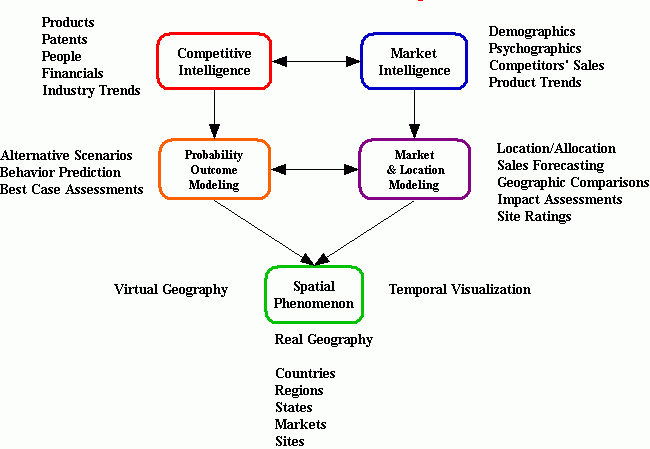
Because of the inter-relationship, there are opportunities to use the techniques of each to ultimately assimilate "spatial phenomena" that drive an enterprise knowledge base into corporate policy.Remember everything happens somewhere, even if the geography is virtual.
The CI people also face the same issues we do in trying to get data
out of tables and into some sort of visualization that make the data come
into focus.One of the ways is to be able to see relationships.A contemporary
example is a visualization of campaign contributions, showing who is giving
how much, to whom.
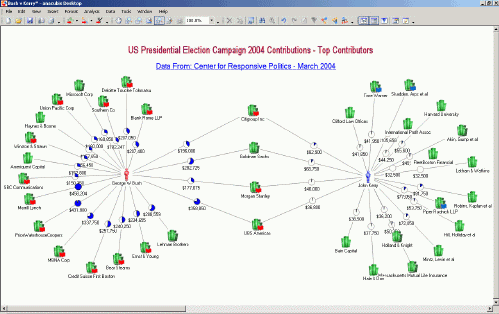
Image courtesy ![]() ®
®
Click for larger image
Another example is in the merger and acquisition field.An example
is the Parmalat organization of recent news fame.A relationship map could
show if this organization was in financial difficulties, what parts of
it might be worth acquiring, or where they were competitively weak.
Below is an example relationship map showing part of the Parmalat holdings and relationships.By using color (thematics), the relationship map can show suppliers, subsidiaries, competitors, non-core business related holdings.
Relationship maps are created when a series of questions are asked. These are some of the questions in sample methodology format from an anacubus® use case.These questions can be derived from a possible scenario and then used to create the relationship map below.
- Who manages the organization?
- What does the competitive landscape look like?
- What is the ownership profile?
- Who is partnering with whom?
- Who owns the intellectual property in this market?
- Who is investing in this market?
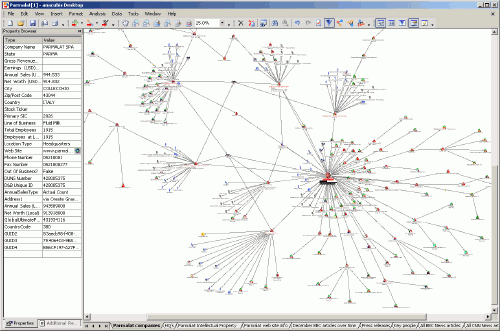
Image courtesy of
Click for larger image
The general attributes of Parmalat are shown on the side.In this case, this panel acts similar to an overview map rather than a legend.Each node can be clicked on to bring up the attributes for that part of the relationship, just like a map.
Note that this is done with a desktop application, using multiple real-time data feeds, and the software builds these relationships on the fly.
Another company, MicroPatent® (East Haven, CT) using several products and techniques (PatentWeb®, Aureka®, ThemeScape® and others) that can mine multiple patent and intellectual property databases (other sources as well) and create visualization in some very fascinating ways. One is a topographic map of relationship densities.This gives the user the ability to see concentrations of documents or data collected and put in a spatial format.The geographic space is created with the pure mathematics of the relationships.See the image below:
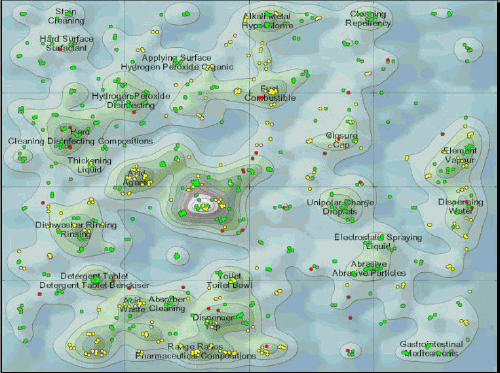
Image courtesy of ![]() ®
®
Click for larger image
This is explanation of this type of visualization from their product, ThemeScape®:
"A ThemeScape map that illustrates the relationship of patent documents to one another topographically. A large concentration of documents is denoted by a peak, with the whitest part, the top, representing the highest concentration of documents related to the listed topic. Valleys reflect a lack of similarity or lack of concentration of documents related to that theme.The topics shown are automatically identified by a ThemeScape algorithm before being topographically displayed."
Documents are derived from their database searches and relate to
the topic that was searched on.
A second form of visualization that I thought was an exceptional way of making the complex visually understandable was a hyperbolic citation tree.This shows an original patent with all of patents that reference the original, downstream patents, patent derivatives and competitors all shown.It looks like this:
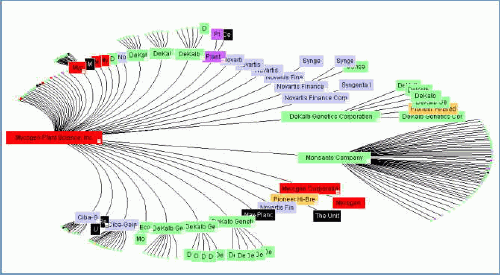
Image courtesy of ![]() ®
®
Click for larger image
The red box (Mycogen Plant Science, Inc.) on the left, is the original patent.The lines connect to other patents that reference this original patent both from competitors or the original patenting company.The key information here is that the red box contains the original technology and looking at the diagram, it could be argued that everything else is a derivative. If you hold the first patent (in the case of Mycogen) you might want to revisit your technology, as it could be the case that everyone else has moved technology far beyond what you originally created and you now control something that is dated technology.Of course, then again, all these other companies may be paying you royalties on your original patent.
Another key part of Competitive Intelligence is the ability to model the possible outcomes of various scenarios, identified trends or events. If your competitor gets a new CEO, or Director or Marketing, what are the possible directions this company will go, given their backgrounds, areas of expertise, successes and failures? Is there a series of seemingly unrelated events that are shaping a new set of industry or product directions?
This type of modeling is directed at creating those strategies and tactics that minimize any exposure or maximize any position from changes in competitive paradigm.This is not performance (sales) prediction, but possibilities predictions.The end result is to build a series of actionable plans, so rather than merely analyzing the data stream, you can identify what might, if anything, be done about what has been analyzed.
This is the type of role companies such as Least Squares Software (http://www.leastsquares.com) plays for the government.Identify the trends, identify the players, assess SWOT and develop the possibilities.
For more insight on how visualization, modeling, and complex feeds of data are handled through software by some very intelligence-oriented parts of the government, look at, http://starlight.pnl.gov/.
A critical piece that we may hold as business geographers is the 4th dimension: the use of time in viewing geography.4DataLink® (http://www.4datalink.com) already does this with networks.They can answer the question of "what did it look like before the outage?" Now if we add this functionality to actionable geography, we complete the picture of CI/BI, Possibility and Performance Modeling, Actionable Geography and now Temporal Understanding.
What has always be an issue with desktop mapping for business analysis is visualization.We never could quite get beyond thematic maps.If we add relationship mapping, the topographic images from MicroPatent®, the modeling from companies like Least Squares and the temporal visualization of companies like 4DataLink®, we may be able to get to the next level of business understanding.
In case you are interested in the scope and methodologies of Competitive
Intelligence, here are some key resources available from the SCIP website
for a better understanding of the use, applications, tools and ethics involved
in this field.
| General info on the SCIP organization | http://www.scip.org |
| Competitive Intelligence - An Overview by Stephen H.Miller, Competitive Intelligence Magazine | http://www.scip.org/Library/overview.pdf |
| Journal of Competitive Intelligence And Management | http://www.scip.org/jcim.asp |
| SCIP Online | http://www.scip.org/news/sciponline.asp |
| The Language of Business Intelligence - By Vernon Prior, Prior Knowledge Includes a dictionary of terms. | http://www.scip.org/ci/languagebi.pdf |
| Job Descriptions | https://www.scip.org/jobs/descriptions.asp |
A key point that this group identifies with is a code of ethics.They are very careful to point out that Competitive Intelligence is research, data mining, clipping services, collections and assessment.It is not espionage. See http://www.scip.org/ci/ethics.asp
The techniques used by CI-ers are not that far a field from what we do to obtain location intelligence.The difference is that their space is virtual and the data can be huge real-time feeds.I would hope that we could expand this link between corporate and location intelligence, so that we can apply geographic response to strategic understanding.